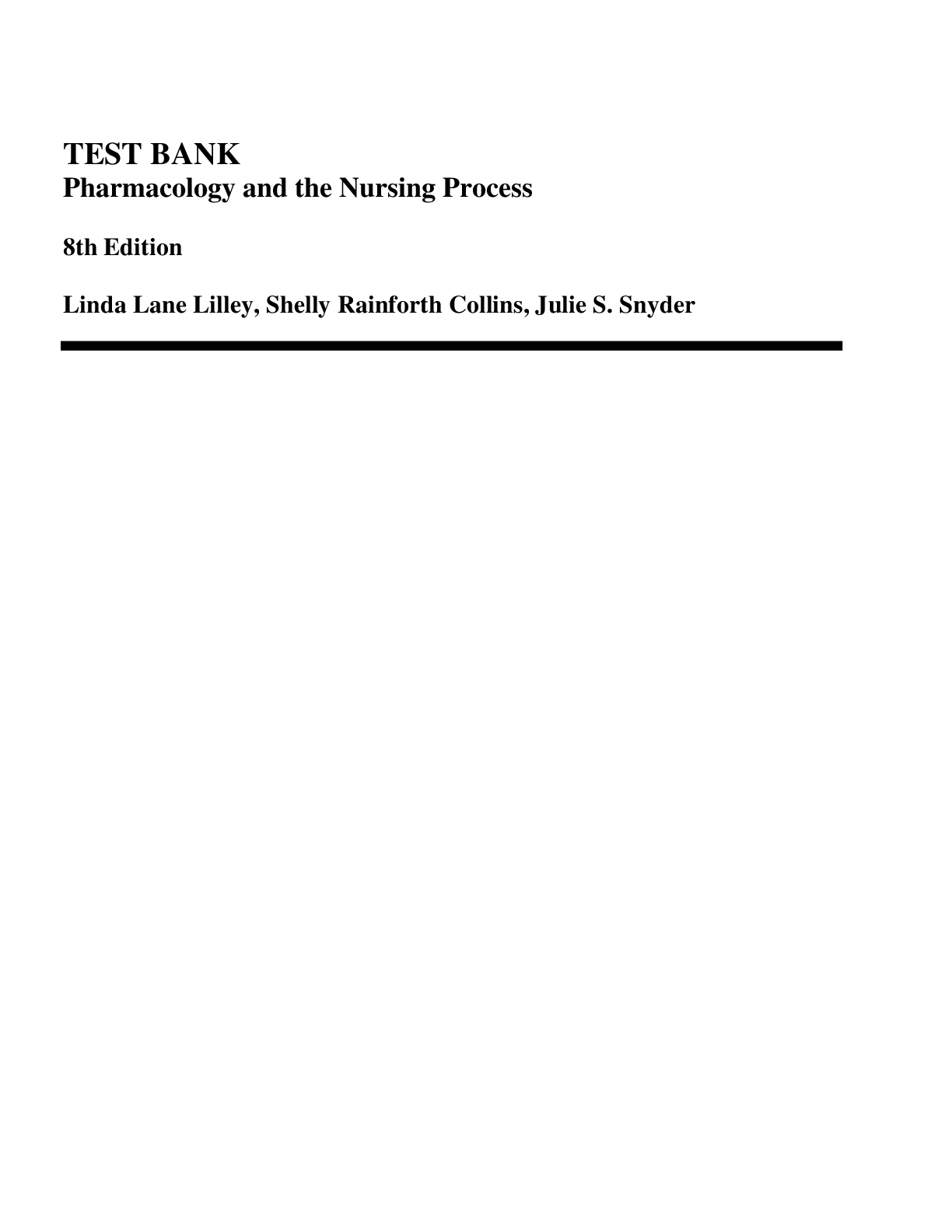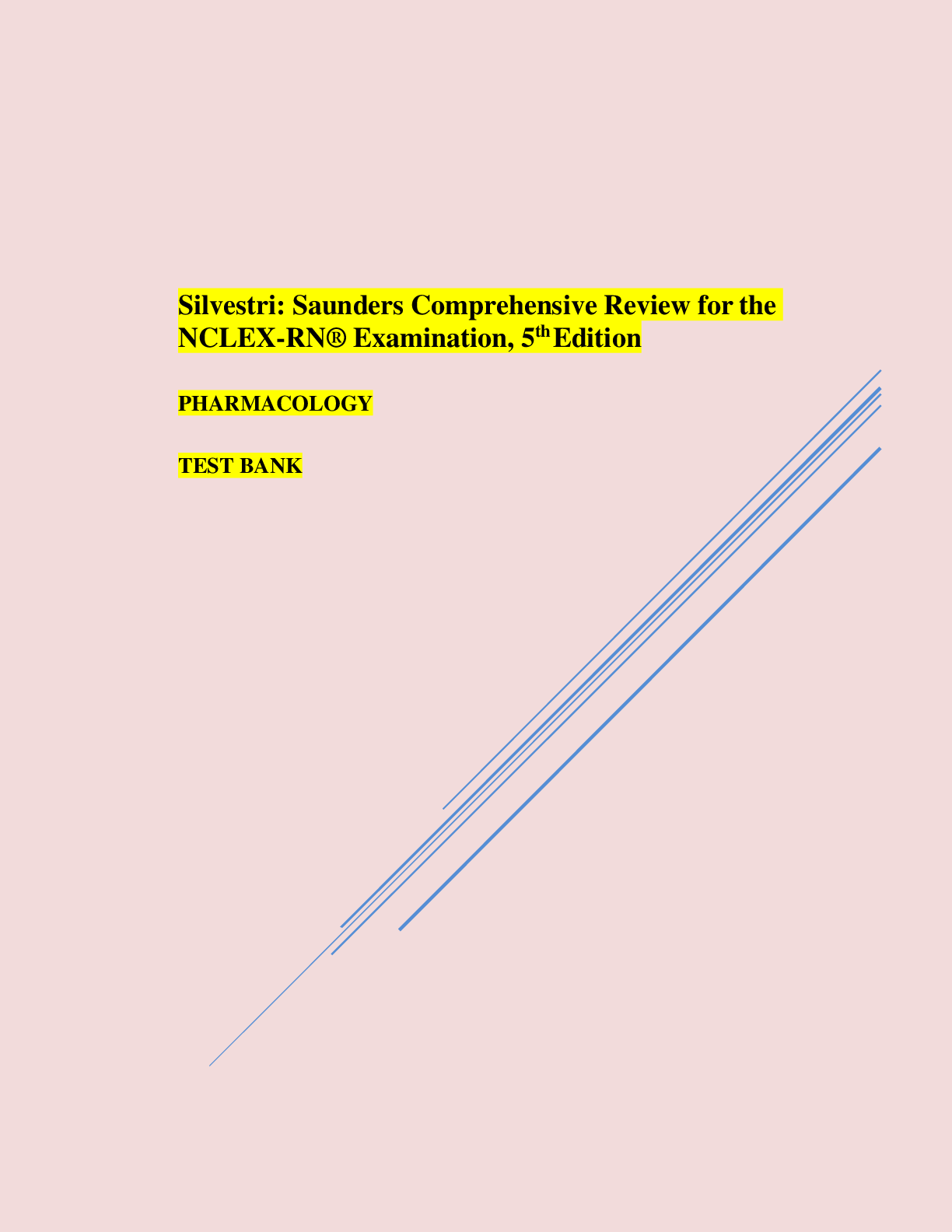Test Bank Chapter 20- Heart Failure and Circulatory Shock
Document Content and Description Below
1.When lecturing to a group of students about the pathophysiological principles behind heart failure, the instructor explains that cardiac output represents: A) Strength of the right ventricular pum... p to move blood B) The amount of blood the heart pumps each minute C) The amount of blood pumped out of the heart with each beat D) The volume of blood stretching the heart muscle at the end of diastole Ans: B Feedback: Cardiac output, which is the major determinant of cardiac performance, reflects how often the heart beats each minute (heart rate) and how much blood it ejects with each beat (stroke volume). Preload reflects the volume of blood that stretches the ventricle at the end of diastole, just before the onset of systole. 2.A client has been experiencing increasing fatigue in recent months, a trend that has prompted an echocardiogram. Results of this diagnostic test suggest that the client's enddiastolic volume is insufficient. Which of the following parameters of cardiac performance will directly decrease as a result of this? A) Inotropy B) Cardiac contractility C) Preload D) Afterload Ans: C Feedback: Preload is the volume of blood stretching the heart muscle at the end of diastole and is normally determined mainly by the venous return to the heart. Afterload represents the force that the contracting heart muscle must generate to eject blood from the filled heart. Cardiac contractility, or inotropy, is the contractile performance of the heart. 3.One of the principal mechanisms by which the heart compensates for increased workload is: A) Myocardial hypertrophy B) Sodium and water retention C) Endothelin vasoconstrictors D) Ventricular wall tension increase Ans: A Feedback: The development of myocardial hypertrophy constitutes one of the principal mechanisms by which the heart compensates for an increase in workload. There are at least two types of endothelin receptors, and it is thought that the peptide may play a role in mediating noncompensatory pulmonary hypertension in persons with heart failure. One effect of a lowered cardiac output in heart failure is a noncompensatory reduction in renal blood flow and glomerular filtration rate, which leads to salt and water retention. Because increased wall tension increases myocardial oxygen requirements, it can produce noncompensatory ischemia and further impairment of cardiac function. Page 1 HEART FAILURE AND CIRCULATORY SHOCK 4.A client with heart failure asks, “Why am I taking a 'water pill' when it's my heart that is having a problem?” While educating the client about the Frank-Starling mechanism, which of the following explanations is most appropriate to share? A) “You must be drinking way too many liquids. Your kidneys cannot filter all that you are drinking during the day.” B) “Since your heart is not pumping efficiently, the kidneys are getting less blood flow; therefore, the kidneys are holding on to sodium and water.” C) “Your heart muscle is overstretched, so it's not able to pump all the blood out. The prescribed 'water pills' help by decreasing your weight.” D) “Since your heart function is impaired, the lungs are not able to oxygenate the blood and your kidneys are wearing out.” Ans: B Feedback: In heart failure with a reduced ejection fraction, a decrease in cardiac output and renal blood flow leads to increased sodium and water retention by the kidney with a resultant increase in vascular volume and venous return to the heart and an increase in ventricular end-diastolic volume. Drinking water may increase volume but is not the physiological reason for retention of fluid. Diuretics do decrease weight as a result of diuresis, but weight loss is not the purpose for giving diuretics. The lungs are not the primary cause of heart failure. 5.The most recent blood work of a client with a diagnosis of heart failure indicates increased levels of atrial natriuretic peptide (ANP) and brain natriuretic peptide (BNP). What is the most likely effect of these peptides on the client's physiology? A) Water retention B) Increased tubular sodium reabsorption C) Inhibition of the renin–angiotensin–aldosterone system D) Sympathetic nervous stimulation Ans: C Feedback: The NPs inhibit the sympathetic nervous system and the renin–angiotensin–aldosterone system, in addition to decreasing tubular sodium and water reabsorption. 6.At the cellular level, cardiac muscle cells respond to an increase in ventricular volume to the point of overload by: Select all that apply. A) Elongating the cardiac muscle cells B) Thickening of the individual myocytes C) Replicating the myofibrils D) Decreasing the ventricular wall thickness E) Symmetrically widening and lengthening the hypertrophy Ans: A, D Feedback: Page 2 At the cellular level, cardiac muscle cells respond to stimuli from stress placed on the ventricular wall by pressure and volume overload by initiating several different processes that lead to hypertrophy. With ventricular volume overload, the increase in wall stress leads to replication of myofibrils in series, elongation of the cardiac muscle cells, and eccentric hypertrophy. Eccentric hypertrophy leads to a decrease in ventricular wall thickness or thinning of the wall with an increase in diastolic volume and wall tension. Production of a symmetric hypertrophy occurs with a proportionate increase in muscle length and width, as occurs in athletes; concentric hypertrophy with an increase in wall thickness, as occurs in hypertension; and eccentric hypertrophy with a disproportionate increase in muscle length, as occurs in dilated cardiomyopathy. When the primary stimulus for hypertrophy is pressure overload, the increase in wall stress leads to parallel replication of myofibrils, thickening of the individual myocytes, and concentric hypertrophy. Concentric hypertrophy may preserve systolic function for a time, but eventually the work performed by the ventricle exceeds the vascular reserve, predisposing to ischemia. 7.From the following clients, who are at high risk for developing heart failure as a result of diastolic dysfunction? Select all that apply. A) A 48-year-old client with uncontrolled hypertension B) A marathon runner with history of chronic bradycardia whose pulse rate is 46 C) A 57-year-old client with history of ischemic heart disease D) A 70-year-old with enlarged left ventricle due to myocardial hypertrophy Ans: A, D Feedback: Conditions that reduce the heart's ability to adequately fill during diastole, such as myocardial hypertrophy and tachycardia, can lead to heart failure. Hypertension remains the leading cause of diastolic dysfunction. Ischemic heart disease is associated with systolic heart failure, or impaired contractile performance. It is normal for athletes, like marathon runners, to have slow pulses. 8.The most common causes of left-sided heart failure include: A) Acute myocardial infarction B) Chronic pulmonary disease C) Impaired renal blood flow D) Tricuspid valve regurgitation Ans: A Feedback: The most common causes of left-sided heart failure are acute myocardial infarction and hypertension. Acute or chronic pulmonary disease can cause right heart failure, referred to as cor pulmonale. The causes of right-sided heart failure include stenosis or regurgitation of the tricuspid or pulmonic valves, right ventricular infarction, and cardiomyopathy. Manifestations (rather than causes) of heart failure reflect the physiologic effects of the impaired pumping ability of the heart, including decreased renal blood flow. Page 3 9.Assessment of an elderly female client reveals the presence of bilateral pitting edema of the client's feet and ankles and pedal pulses that are difficult to palpate. Auscultation of the client's lungs reveals clear air entry to bases, and the client's oxygen saturation level is 93%, and vital signs are within reference ranges. What is this client's most likely health problem? A) Right-sided heart failure B) Pericarditis C) Cardiogenic shock D) Cor pulmonale Ans: A Feedback: A major effect of right-sided heart failure is the development of peripheral edema. A client who is in shock would not have stable vital signs. Cor pulmonale would be accompanied by manifestations of lung disease. Pericarditis is an inflammation of the pericardium exhibited by fever, precordial pain, dyspnea, and palpitations. 10.While teaching a client with new-onset right-sided heart failure, the nurse should educate the client to monitor for fluid accumulation by: A) Weighing every day at the same time with same type of clothing B) Measuring all of the client's urine output daily to check for a decrease in output C) Listening to the breath sound with a stethoscope every morning D) Take blood pressure daily and call doctor if it is decreased Ans: A Feedback: When the right heart fails, a damming back of blood occurs, leading to its accumulation in the systemic venous system, causing an increase in right atrial, right ventricular enddiastolic, and systemic venous pressures. The accumulation of fluid (edema) is evidenced by a gain in weight (i.e., 1 pint of accumulated fluid results in a 1-pound weight gain). Shortness of breath due to congestion of the pulmonary circulation is one of the major manifestations of left-sided heart failure. It is unrealistic to expect clients to listen to their own breath sounds. BP measurement could be an intervention; however, it is not a primary indicator of edema from right-sided heart failure. With impairment of left heart function, there is a decrease in cardiac output, with resulting decreased renal perfusion and output. 11.The shortness of breath and cyanosis that occur in clients experiencing acute heart failure syndrome are primarily caused by: Select all that apply. A) Accumulation of fluid in the alveoli and airways B) Lung stiffness C) Worsening renal failure D) Myocardial muscle necrosis E) Impaired gas exchange Page 4 Ans: A, B, E Feedback: Acute pulmonary edema is the most dramatic symptom of AHFS. It is a life-threatening condition in which capillary fluid moves into the alveoli. The accumulated fluid in the alveoli and airways causes lung stiffness, makes lung expansion more difficult, and impairs the gas exchange function of the lung. With the decreased ability of the lungs to oxygenate the blood, the hemoglobin leaves the pulmonary circulation without being fully oxygenated, resulting in shortness of breath and cyanosis. Worsening renal failure and MI may cause volume overload but are more likely secondary causes of chronic heart failure. 12.While in the ICU, a client's status changes. The health care providers suspect heart failure. Which of the following diagnostic procedures would give the staff information about pulmonary capillary pressures, which will lead to the most appropriate interventions? A) Echocardiography B) Radionuclide ventriculography C) Cardiac magnetic resonance imaging D) Hemodynamic monitoring Ans: D Feedback: Invasive hemodynamic monitoring may be used for assessment in acute, life-threatening episodes of heart failure. These monitoring methods include central venous pressure (CVP), pulmonary artery pressure monitoring, measurements of cardiac output, and intraarterial measurements of blood pressure. Echocardiography plays a key role in assessing ejection fraction, right and left ventricular wall, wall thickness, ventricular chamber size, valve function, heart defects, and pericardial disease. Radionuclide ventriculography is recommended if there is reason to suspect coronary artery disease or ischemia as the underlying cause for heart failure. Cardiac magnetic resonance imaging and cardiac computed tomography are used to document ejection fraction, ventricular preload, and regional wall motion. 13.A nurse is performing client health education with a 68-year-old man who has recently been diagnosed with heart failure. Which of the following statements demonstrates an accurate understanding of his new diagnosis? A) “I'll be sure to take my beta blocker whenever I feel short of breath.” B) “I'm going to avoid as much physical activity as I can so that I preserve my strength.” C) “I know it's healthy to drink a lot of water, and I'm going to make sure I do this from now on.” D) “I'm trying to think of ways that I can cut down the amount of salt that I usually eat.” Ans: D Feedback: Page 5 Salt and fluid restrictions are indicated for most clients with heart failure (HF). Beta blockers do not address shortness of breath, and cardiac medications are not normally taken in response to acute symptoms. Clients should be encouraged to maintain, and increase, physical activity within the limits of their condition. 14.A client with a diagnosis of heart failure has returned from a visit with his primary care provider with a prescription for a change in his daily medication regimen. Which of the following drugs is likely to improve the client's cardiac function by increasing the force and strength of ventricular contractions? A) A -adrenergic blocker B) A diuretic C) A cardiac glycoside D) An ACE inhibitor Ans: C Feedback: Cardiac glycosides improve cardiac function by increasing the force and strength of ventricular contractions. -Adrenergic blockers decrease left ventricular dysfunction associated with activation of the sympathetic nervous system. ACE inhibitors block the conversion of angiotensin I to II, whereas diuretics promote the excretion of fluid. 15.A client awaiting a heart transplant is experiencing decompensation of her left ventricle that will not respond to medications. The physicians suggest placing the client on a ventricular assist device (VAD). The client asks what this equipment will do. The health care providers respond: A) “Pull your blood from the right side of the heart and run it through a machine to oxygenate it better, and then return it to your body.” B) “Measure the pressures inside your heart continuously to asses pumping ability of your left ventricle.” C) “Have a probe at the end of a catheter to obtain thermodilution measures, so cardiac output can be calculated.” D) “This device will decrease the workload of the myocardium while maintaining cardiac output and systemic arterial pressure.” Ans: D Feedback: Refractory heart failure reflects deterioration in cardiac function that is unresponsive to medical or surgical interventions. Ventricular assist devices (VADs) are mechanical pumps used to support ventricular function. VADs are used to decrease the workload of the myocardium while maintaining cardiac output and systemic arterial pressure. This decreases the workload on the ventricle and allows it to rest and recover. The rest of the distractors relate to the monitoring in an ICU of cardiac functioning. Invasive hemodynamic monitoring may be used for assessment in acute, life-threatening episodes of heart failure. With the balloon inflated, the catheter monitors pulmonary capillary pressures (i.e., pulmonary capillary wedge pressure or pulmonary artery occlusion pressure), which reflect pressures from the left ventricle. The pulmonary capillary Page 6 pressures provide a means of assessing the pumping ability of the left ventricle. One type of pulmonary artery catheter is equipped with a thermistor probe to obtain thermodilution measurements of cardiac output. 16.An 86-year-old male client is disappointed to learn that he has class II heart failure despite a lifelong commitment to exercise and healthy eating. Which of the following age-related changes predisposes older adults to developing heart failure? A) Increased vascular stiffness B) Orthostatic hypotension C) Increased cardiac contractility D) Loss of action potential Ans: A Feedback: Increased vascular stiffness in older adults causes a progressive increase in systolic blood pressure with advancing age, which in turn contributes to the development of left ventricular hypertrophy and altered diastolic filling. A loss of action potential does not typically accompany aging, and contractility tends to decrease as a result of cardiac stiffness. Orthostatic hypotension is neither a normal age-related change nor a cause of heart failure. [Show More]
Last updated: 1 year ago
Preview 1 out of 11 pages
Instant download
 (1).png)
Buy this document to get the full access instantly
Instant Download Access after purchase
Add to cartInstant download
Reviews( 0 )
Document information
Connected school, study & course
About the document
Uploaded On
May 12, 2022
Number of pages
11
Written in
Additional information
This document has been written for:
Uploaded
May 12, 2022
Downloads
0
Views
34








 (1).png)
_compressed.png)




